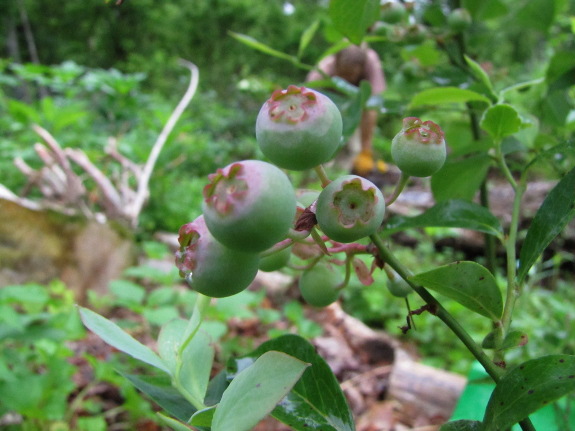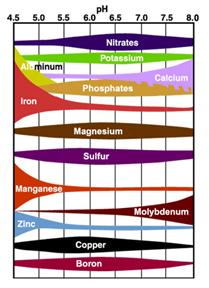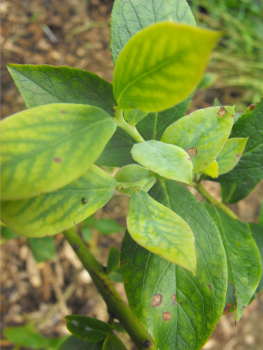
Managing blueberry soil micronutrients

My next thorny question
was --- how closely can I apply Solomon's
soil analysis guidelines to woody plants?
Refreshing my memory of The
Holistic Orchard
suggests most woody plants might enjoy the same soil conditions Solomon
guides us toward. But blueberries are another matter.
Optimal vegetable garden
pH is supposed to be around 6.0 to 6.5, but blueberries like it more
acidic --- 4.5 to 5.5, with 6.0 being permissible for the
easier-to-please rabbiteyes. And despite lots of pine needle
mulch, pine
logs edging the beds,
pine
humus in the root zone, and even sulfur given to half the plants their
first season, the pH
in my blueberry patch is 6.5.
 While
6.5 sounds bad for blueberries, Solomon and Phillips both suggest that
higher pH may not be as much of a problem as other writers
suggest. With vegetables, Solomon finds a pH of 7.5 is fine as
long as you even out cation excesses, and he reminds us that the pH of
our soil may appear
much lower to our plants than it does in the testing lab since plant
roots hang out around organic matter and organic matter creates pockets
of acidity. (Microorganisms eat organic matter and exude carbon
dioxide as a waste product, and the gas mixes with water to form
carbonic
acid.) But can blueberries really handle a pH of 6.5 even if the
soil has a CEC of 12.6?
While
6.5 sounds bad for blueberries, Solomon and Phillips both suggest that
higher pH may not be as much of a problem as other writers
suggest. With vegetables, Solomon finds a pH of 7.5 is fine as
long as you even out cation excesses, and he reminds us that the pH of
our soil may appear
much lower to our plants than it does in the testing lab since plant
roots hang out around organic matter and organic matter creates pockets
of acidity. (Microorganisms eat organic matter and exude carbon
dioxide as a waste product, and the gas mixes with water to form
carbonic
acid.) But can blueberries really handle a pH of 6.5 even if the
soil has a CEC of 12.6?
The trouble with high pH
in the blueberry patch is that it makes it tough for blueberries to
find iron, especially if excess calcium is around. Some sources
suggest balancing blueberry soil with less calcium and more magnesium
than you'd allow in your vegetable garden,  especially since magnesium
can also be hard for blueberries to find. Luckily, my soil
already trends toward low calcium and high magnesium levels, so all I
have to do is leave it alone to achieve that goal.
especially since magnesium
can also be hard for blueberries to find. Luckily, my soil
already trends toward low calcium and high magnesium levels, so all I
have to do is leave it alone to achieve that goal.
Iron deficiencies are
usually pretty easy to see in blueberry leaves during the growing
season, as you can see in the photo to the left. I recall
noticing yellowed leaves during the blueberries' first year or two, but
not more recently...but I also tend to ignore the blueberries while the
vegetable garden is calling my name. So I think I'm going to
table this issue for now and check over the patch once the leaves come
back out. I definitely won't be adding any lime to the
blueberries' soil, though, and if I do decide to boost the sulfur
levels, I'll do so with ag sulfur instead of with gypsum.
This
post is part of our The Intelligent
Gardener lunchtime series.
Read all of the entries:
|
Want more in-depth information? Browse through our books.
Or explore more posts by date or by subject.
About us: Anna Hess and Mark Hamilton spent over a decade living self-sufficiently in the mountains of Virginia before moving north to start over from scratch in the foothills of Ohio. They've experimented with permaculture, no-till gardening, trailersteading, home-based microbusinesses and much more, writing about their adventures in both blogs and books.
Want to be notified when new comments are posted on this page? Click on the RSS button after you add a comment to subscribe to the comment feed, or simply check the box beside "email replies to me" while writing your comment.

The photo you are showing is not an iron deficiency, it is a manganese deficiency, maybe even induced from and iron and aluminum toxicity. A good leaf analysis taken from the leaves next to the fruit will demonstrate my point.
You have no Mn in your soil...